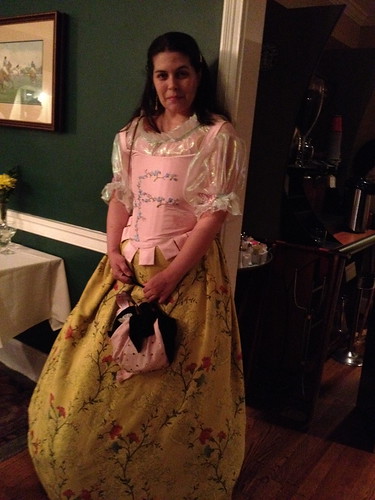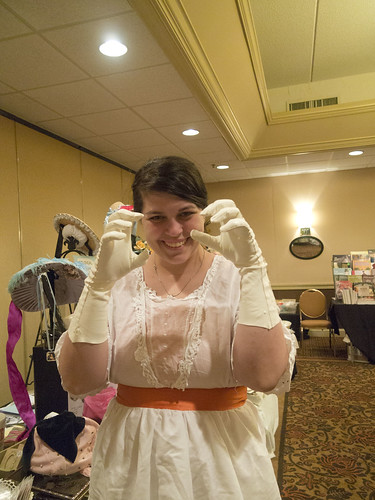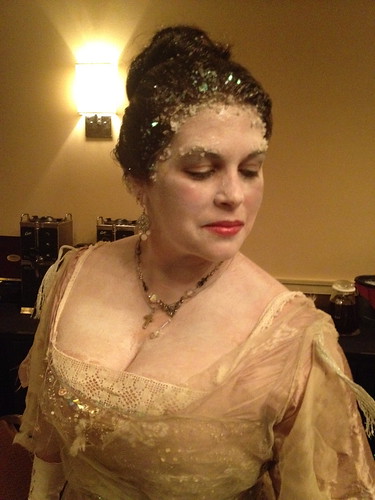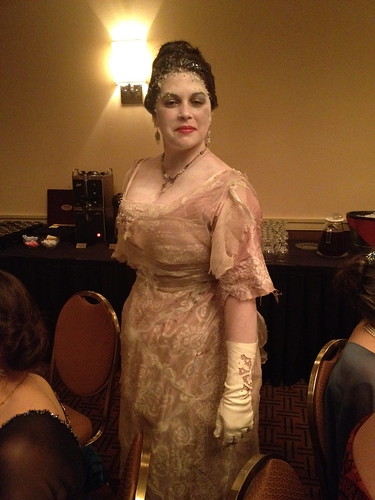At Dress U, I taught a class regarding using search engines like Bing and Google as well as searching on ebay for costume related items. Basically, it was about learning various formulas that work in the search engines to better refine your searches. I've included examples and hope this is clear. Please, feel free to comment with any questions!
Quotation marks:
""s around a word or phrase help to look for that EXACT item. Capitalization isn't important but spelling is. Using quotes around a phrase helps immensely when looking for something like examples of a Robe a l'anglaise. In any search box, just use "Robe a l'anglaise" to find the 18th Century fitted back gowns. On both google and bing, it will come up with appropriate links as well as images.
The beloved minus sign:
I <3 the - sign in searching. I use it rather liberally and suggest everyone else to do so as well. The - is used to get rid of terms you don't want. So, let's say you are searching for a green dress but you don't want a yellow one. Your search term would be as follows
"green dress" -yellow. This way, anytime yellow shows up on a webpage with the phrase green dress, that webpage will not be included in your results. You don't have to use exact phrasing (quotes).
On eBay, they have an even more sophisticated method. If you are searching for a green dress but not any other colors, all you need to do is the following
green dress -(yellow, blue, red, pink, orange, purple, black, white). Ebay will allow up to 10 search terms inside the parenthesis. For both Bing and Google you need to add a - before each term. Also, both Bing and Google seem to have a lower limit for the amount of negative terms you can add.
It was just here, on this site, I know it!
We've all been there. You see something pretty, think "Oh, that's nice", continue on your merry way only to think you might want to bookmark that site later and.....it's gone. The item you just saw - that black 18th C gown or that lovely silk fabric- is no where to be found now and you can't recall exactly how you got to it in the first place. The site: function is for you.
In the search box of either Bing or Google (I'm sure it works on Yahoo and Ask as well) type the following
site:www.metmuseum.org blue silk and it will search the entire Met museum for any page that contains the words both blue and silk somewhere on it. This function is only good, however, if the page itself is public and not private (ie, doesn't work quite as well on blogs.)
I kinda sorta think maybe this or this or that but they all mean the same thing...
As we all know, in the costuming world, we can very easily have ten terms that mean the exact same thing. On one page a dress might be called a gown, a robe, formal attire, ect. You want to be able to find all the terms that refer to that one item. Rather than doing multiple searches, just use the ~. By placing the ~ before a term, it means "like". So
~dress will also search for, at least, gown. It's basically pulling from a thesaurus and looking at every similar term.
All I know is it was some PDF that had pretty pictures
This is something I've done. You find a pdf that has awesome research and your computer dies on you or you otherwise forget to save it. You have NO idea where the pdf was hosted, all you know is it had information on your topic and it was a specific type of file that was not a webpage.
Filetype: can be used with any file type. Let's say you saw a nice Word doc on women's renaissance shoes but you can't find it again - just type into your search bar
filetype:doc renaissance shoes and it should find the file for you. If the file was a pdf, then use
filetype:pdf renaissance shoes . It works very well in both Google and Bing.
I only want to see items from the 1880's!
Trying to sort through the wedding dresses when all you are looking for is a bustle gown is highly annoying. You keep getting links of Vera Wang when all you want is House of Worth! To help narrow your search by a decade, used the following
1881...1890 bustle dress This will force the search engine to only search for pages that have a number between 1881 and 1890 on the page plus the words Bustle and dress. Although this helps narrow the search for links, it doesn't work well on images since a wedding gown can still be number 1882 as the price or as the retail number. Of course, this will work with any decade. :-) Or, century if you want to see everything from 1701 to 1800, of course.
The almighty wildcard, *
I probably overuse the asterisk.
It's GREAT when searching for items that have the same root but have multiple endings. My favorite example is embroidery. It can be embroidering, embroidered, embroideries, and yet, it all means the exact same thing. It just depends on what the seller or webpage owner decides to use. Since embroider is at the heart of each of those terms, just use
embroider* as your search term. You can, sometimes, use the wildcard (*) at the start of a term but it works much better at the end of a search term.
Google Image Search [Insert Drool Here]
The new Google Image Search is awesome. Have you ever saved an image to your computer and forgotten where you got it from?
Go to Google, click on images on the upper bar, and up should come a search screen where there is a camera in the search bar. Click on the camera to upload the photo you want to search on. If it's still on the web, Google will find it.
Google is also very good at finding where other people got their images from (tumblr /cough). That pretty dress that has no sourcing with it on a blog post? Just right click on the image, go to properties and see the address of the image. Copy the address and paste it in the search bar. Google will find it.
On Bing and Google, if you see an image in your searching results that you like but it's not quite right or it's too small, they both have functions to find "similar" or "other sizes" of the image. Don't give up if it says that's the only size in that image, do a similar search and you'll often see the exact same image right next to the one you just searched. Click on the second image and do a "more sizes" search. I've found images that are much bigger than my first results this way - which is great for movie costume recreations.
That's it! Feel free to ask questions and I do hope this was helpful for both those that took the course and those that weren't able to make it.







